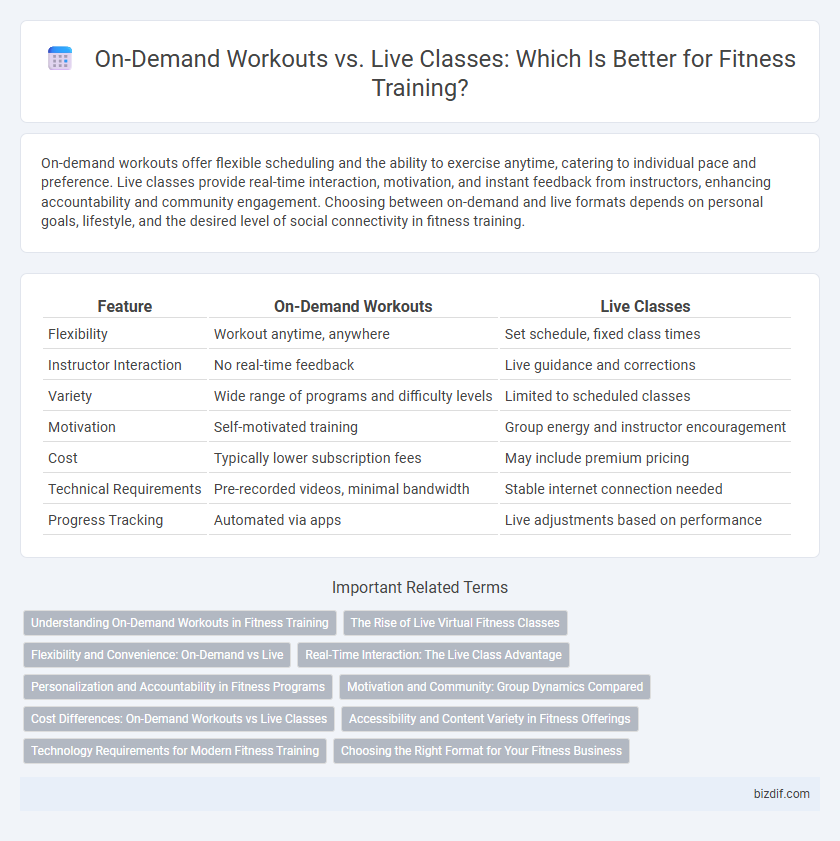On-demand workouts offer flexible scheduling and the ability to exercise anytime, catering to individual pace and preference. Live classes provide real-time interaction, motivation, and instant feedback from instructors, enhancing accountability and community engagement. Choosing between on-demand and live formats depends on personal goals, lifestyle, and the desired level of social connectivity in fitness training.
Table of Comparison
| Feature | On-Demand Workouts | Live Classes |
|---|---|---|
| Flexibility | Workout anytime, anywhere | Set schedule, fixed class times |
| Instructor Interaction | No real-time feedback | Live guidance and corrections |
| Variety | Wide range of programs and difficulty levels | Limited to scheduled classes |
| Motivation | Self-motivated training | Group energy and instructor encouragement |
| Cost | Typically lower subscription fees | May include premium pricing |
| Technical Requirements | Pre-recorded videos, minimal bandwidth | Stable internet connection needed |
| Progress Tracking | Automated via apps | Live adjustments based on performance |
Understanding On-Demand Workouts in Fitness Training
On-demand workouts in fitness training offer flexible access to pre-recorded sessions anytime, allowing users to tailor their exercise routine to personal schedules without the constraints of fixed class times. These workouts provide diverse options across intensity levels, styles, and durations, enabling customized fitness progression and consistent motivation. Leveraging on-demand platforms helps individuals track performance metrics and integrate training plans that suit specific goals, enhancing overall workout efficiency and adherence.
The Rise of Live Virtual Fitness Classes
Live virtual fitness classes have surged in popularity, offering real-time interaction and personalized coaching that on-demand workouts lack. These sessions foster community engagement and accountability, driving higher motivation and consistency among participants. Advanced streaming technology ensures seamless delivery, making live classes an accessible and dynamic option for diverse fitness levels.
Flexibility and Convenience: On-Demand vs Live
On-demand workouts offer unmatched flexibility by allowing users to exercise anytime and anywhere, fitting seamlessly into diverse schedules. Live classes provide real-time interaction and motivation but require participants to commit to specific times, limiting convenience. Choosing between on-demand and live formats depends on the user's need for scheduling autonomy versus the energy of a communal workout environment.
Real-Time Interaction: The Live Class Advantage
Live fitness classes offer real-time interaction that enhances motivation and accountability, allowing instant feedback from instructors to correct form and prevent injury. This immediate engagement fosters a sense of community and connection, which is often missing in on-demand workouts. The dynamic environment of live classes drives higher commitment and performance through personalized guidance.
Personalization and Accountability in Fitness Programs
On-demand workouts offer personalized fitness routines tailored to individual goals and schedules, allowing users to progress at their own pace with customized intensity levels. Live classes provide real-time interaction, fostering accountability through instructor feedback and group motivation, which enhances commitment and consistency. Combining both methods leverages the benefits of flexible personalization while maintaining the accountability needed for sustained fitness progress.
Motivation and Community: Group Dynamics Compared
On-demand workouts offer flexibility but often lack the immediate motivation and accountability found in live classes, where real-time interaction fosters a stronger sense of community and group support. Live classes enhance motivation through shared energy and direct instructor feedback, boosting participant engagement and commitment. Group dynamics in live settings create a collective experience that encourages consistency and a deeper emotional connection to fitness goals.
Cost Differences: On-Demand Workouts vs Live Classes
On-demand workouts typically offer more cost-effective options with monthly subscriptions ranging from $10 to $30, while live classes often charge per session between $15 and $40 or higher for boutique studios. The flexibility of on-demand platforms like Peloton or Beachbody allows users to access hundreds of workouts for a single fee, whereas live classes emphasize personalized interaction and real-time feedback at a premium price. Budget-conscious fitness enthusiasts can maximize savings by opting for on-demand programs without sacrificing variety or quality.
Accessibility and Content Variety in Fitness Offerings
On-demand workouts provide unparalleled accessibility by allowing users to exercise anytime and anywhere, accommodating diverse schedules and fitness levels. Live classes offer real-time interaction and motivation, appealing to those who thrive on community engagement and instant feedback. Together, these formats expand content variety significantly, catering to personalized fitness goals and enhancing overall user experience.
Technology Requirements for Modern Fitness Training
On-demand workouts require a stable internet connection and compatible devices such as smartphones, tablets, or smart TVs to access pre-recorded fitness content anytime. Live classes demand real-time streaming capabilities with high bandwidth and often integrate interactive features like live chat or instructor feedback through platforms optimized for video conferencing. Both formats benefit from advanced fitness apps and wearable technology to track performance and personalize training experiences in modern fitness training.
Choosing the Right Format for Your Fitness Business
On-demand workouts offer flexibility and convenience, allowing clients to exercise anytime with access to a wide variety of routines tailored to different fitness levels. Live classes foster real-time interaction, motivation, and community engagement, enhancing accountability and personalized feedback. Fitness businesses should evaluate their target audience's preferences, technological infrastructure, and scalability goals to choose the most effective format that maximizes client retention and satisfaction.
On-demand workouts vs Live classes Infographic

 bizdif.com
bizdif.com